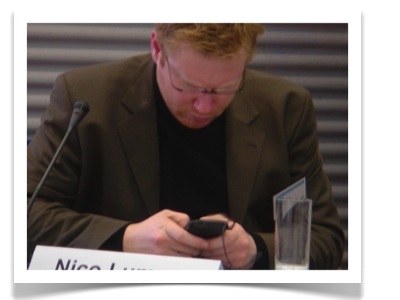
Video-conferencing was a big hype in the 1990s when it was promoted as a way to replace traditional meetings. As with much hype, it was followed by a “disillusionment” phase.
People simply preferred traditional meetings. In the meantime, video gradually entered into international conference rooms and meetings. Today, it is normal to have the keynote address delivered via video. Here is an example of one of fathers of the Internet, Vint Cerf, addressing the 4th Annual Meeting of the Internet Governance Forum in Sharm El Sheikh, 2009 (video by Seiiti Arata).

In addition to delivering keynote speeches, video is increasingly used for tele-conferencing.Two sets of developments triggered more intensive use of video tele-conferencing.
One comes from the “demand side”… Security concerns have made travel increasingly uncomfortable. Anyone experiencing airport security would think twice before decide to travel by plane. Another new development is a growing climate change consciousness of the C02 emissions that every trip generates.
On the “supply side”… Nowadays video-conferencing technology is much more mature. On the high-priced end of the market, Intel and other companies provide turn-key solutions that simulate real tele-presence. Recently, I attended one of those presentations which caused me to try to shake hands with my interlocutor who was a thousand kilometres away! The problem is that these professional systems are still very expensive (more than Euro 100.000) and not portable. On the low-cost side, Skype and other Internet providers are developing technological solutions. But they still have to mature before they will be seamless tools. One main problem that still remains is Internet bandwidth that cannot guarantee smooth video (all of us have experienced frozen images and garbled audio).
Diplomatic services and international organisations are increasingly using video-conferencing for internal coordination and meetings. I am sure that you can provide some examples of the successful use of video-conferencing. Please describe your experiences by commenting below.
A good summary of open questions about video-conferencing is provided by the WWF study “Vitual Meetings and Climate Innovation in the 21st Century”. As has happened in the past, more experience will answer many questions, including:
- in what circumstances can video-conferencing appropriately replace face-to-face meetings (e.g. brainstorming, negotiations)?
- what practical techniques are indispensable for running an effective video-conferencing meeting?



